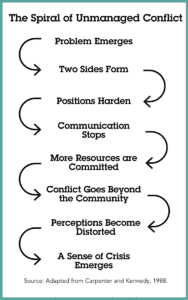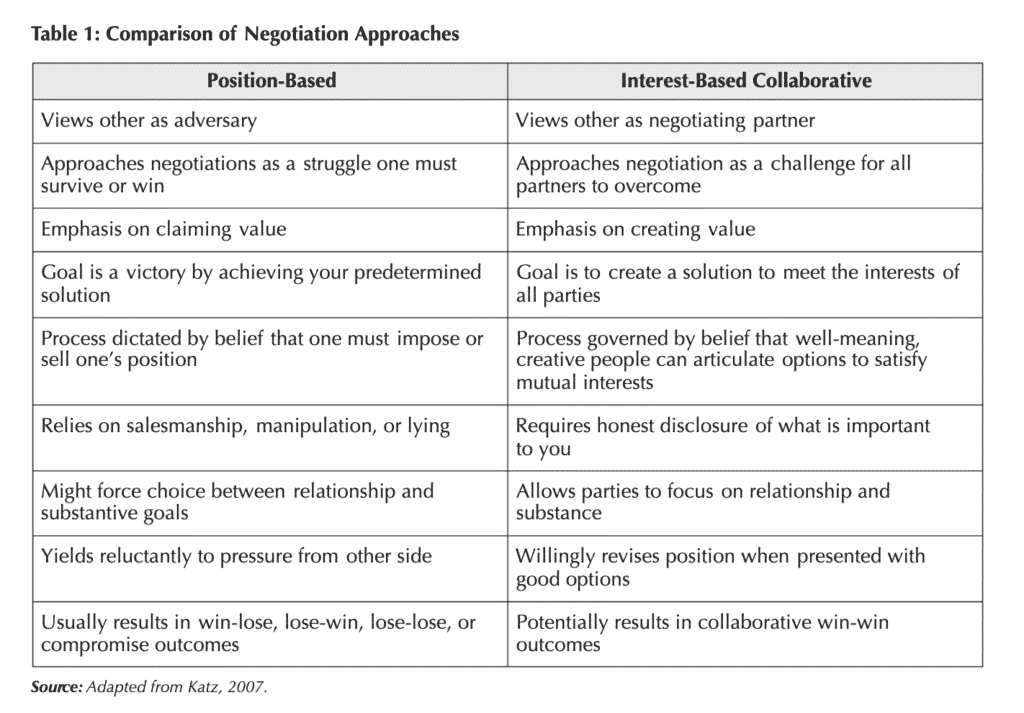
Conflict Resolution in Coalitions: Causes and Solutions
“I assume that every collaboration will bring conflict that must be managed”
⏤ Nancy Cantor Tweet
Conflict in a coalition is normal – in fact, it’s usually a sign that the coalition or network is quite strong and engaged. Its members are passionate and involved, suggesting there is something “worth fighting for.” This essential fact means conflict resolution in coalitions is a key skillset for network leaders. They need the right tools and knowledge to be able to guide a network of partners towards a solution that works for all. Here’s a guide on the causes of conflict in a network or coalition, along with a tried-and-true method for conflict resolution in coalitions.
The Paradox of Collaboration & Conflict
Contrary to popular belief, collaboration in a network or coalition typically leads to more, rather than less conflict. As a unique and horizontal organizational form, networks are prone to many kinds of conflict inherent to their form. Understanding some of the causes of conflict can help you better navigate, pre-empt and avoid them in the first place. These are some common sources of collaborative conflict in a network or coalition of community partners.
Conflicting Missions and Goals
Each participant in coalition brings their own goals and mission with them. While all members agree on some central aspects of their goal (or they would not have joined the network), there are often areas of disagreement. For example, a network initiative could shift funding away from some member programs in other areas, creating conflict.

Varying Organizational Cultures
Every organization and community has its own unique culture – a set of assumptions and values that underly our actions. When different groups come together, these varying assumptions can lead to significant issues, especially if they are never acknowledged upfront.
Different Stakeholders and Funders
Different types of organizations serve different constituencies. A nonprofit may care most about how their donors perceive the coalition’s work, while government agencies may be more concerned with the opinion of elected or appointed political overseers. Private sector groups are primarily concerned with how their customers view their network participation. These divergences lead quickly to conflict.
A Multitude of Overlapping Issues
Many networks focus on systemic issues like food security, health equity, or education that are deeply connected to other issue areas. Taking action in one area often means impact numerous others, both positively and negatively. For example, finding ‘win-win’ strategies that positively impact numerous issues will win more support than tactics that silo efforts, or actually exacerbate other social problems.
Diverse Personalities & Communication Styles
All organizations are composed primarily of people. Sometimes conflict is less about goals, resources, and stakeholders, and more about personalities and communication styles. Usually, it is possible to facilitate solutions to people-driven conflict, but other times it can require swapping out a representative or finding better ways to communicate with argumentative-prone individuals.
Coalition Conflicts Over Turf
The last source of conflict is one of the biggest – arguments over turf. This typically refers to disagreement about the way resources, recognition, and power is shared and distributed across the network. For example, an organization that has spent significant resources to build up a tool may be wary of sharing it without proper recognition or even reimbursement. Turf conflict has its own set of tips for conflict resolution in coalitions. This Brief has great options for addressing these unique types of conflict.
The Spiraling Cycle of Conflict

If and when you notice a conflict between any partners in your coalition, it’s key to act fast. Get in touch with all those directly involved and start gathering information about the problem background. This will set the stage to engage in collaborative problem-solving using interest-based negotiation, a powerful tool for conflict resolution in coalitions. Here’s how it works.
Conflict Resolution in Coalitions with Interest-Based Negotiation
When most people think of negotiation, they imagine a car salesman and potential buyer haggling over the price. This competitive-style negotiation is zero-sum in nature, assuming that the car salesman’s gain is the buyer’s loss, and vice versa. The end result is often a compromise that leaves both sides unsatisfied and sows resentment or distrust.
Interest-based negotiation is a powerful alternative. Instead of focusing on each side’s position, this process focuses on identifying the specific interests that determine a party’s position. For example, consider an organization demanding a greater share of the coalition’s funding. Instead of haggling over a specific amount, the coalition can ask questions to understand why they want more funding, and how it would benefit them, to identify alternative ways to meet these interests without a funding shift. For example, if the underlying interest is a need for more staff, the network could offer to share volunteers with them to share the burden of work.
Below is a comparison of these two negotiation approaches to help you better understand the core differences. Now let’s talk about the eight steps to engage in interest-based negotiation for conflict resolution in coalitions.

1) Define the issue and frame it as a dilemma or challenge to be solved together.
Instead of viewing other parties as adversaries, emphasize the collective nature of the problem to be solved as an issue you must all solve together. It can be helpful to frame the problem as a How-to question to help others approach it with a problem-solving, solution-oriented perspective, instead of adversarially.
2) Educate each other about your interests: disclose, listen, and ask.
Fight the urge to jump into discussions about solutions, so you can better understand the group’s motivations for their positions. Be open and honest from the beginning, sharing why this issue is important to you and how it affects you. Then give others a chance to share, and ask open-ended follow-up questions to probe deeper. It is not possible to begin identifying solutions until everyone understands the varying interests that must be met.
3) Look for ways to “expand the pie”: create value before you claim value.
Try to “unbundle” the various issues being debated and discussed so they can be addressed and considered individually. For example, if the debate is over funding, try to discuss the underlying issues of time and staff constraints. This creates opportunities to expand the pie and create value – like offering to share volunteers. Consider the differences between members, like time constraints, or risk tolerance, to offer unique value to individual partners within the network. If a partner cannot afford an immediate funding request, consider if it can be done over time, or if they can grant in-kind gifts. Difference is a powerful source of value.

4) Generate multiple options for settlement; if you get stuck, go back and review what people’s interests are.
This is often done with the help of a trained facilitator, or someone in the network with a similar background. Brainstorm solutions as a group that would meet all identified interests and write them down. Avoid critiquing ideas at this stage so you do not discourage people from sharing ideas. The more options you generate, the better.
5) Evaluate the options (how well do they meet needs?).
Once you have a list of ideas, you can begin evaluating how well they each meet your identified group needs. It is a good idea to come to an agreement on the standards you will use to evaluate them – for example, you could consider the cost, implementation difficulty, and external support for each potential solution, in addition to how well they meet everyone’s interests. Many groups use a grid, with options on one axis and standards along the other to ranked each idea in each area.
6) Select/modify options based on which ones meet needs most.
At this point, there are usually several favorite ideas worthy of further consideration. You can use the ideas as stages for a plan, or prioritize them. To create a win-win solution that works for everyone, try combining various ideas and options that incorporate their varying needs and intereests.
7) Use objective criteria to resolve impasses.
Conflict resolution in coalitions often results in conflict during the process itself. When an impass arises on a particular point, try to rely on objective criteria like research, data, law, and other sources of authority. Avoid relying on power or coercion to get your way, instead using principled discussion and active listening.
8) Develop a plan to implement the agreement including monitoring
Once you have an agreement, take time to make a detailed plan for implementing it. Account for who will be responsible for doing what, and at what time. There should also be a mechanism for monitoring and reporting back on the progress of the agreement and implementation, which can reduce future conflict due to miscommunication.
Conflict Resolution in Coalitions: Now You Know!
Conflict is inevitable in a network of partners due to many factors, but it need not be a crisis. By acting quickly when conflict arises, you can prevent it from spiraling out of control. The key is probing beyond positions to focus on the foundational interests relevant to the problem. Then, taking a group problem-solving approach, you can brainstorm and evaluate solutions collectively to identify a win-win option that works for everyone. Good luck engaging in conflict resolutions in coalitions!
This blog shares advice and findings from the IBM Center’s Guide on Conflict Resolution in Coalitions, which you can read here.

About the Author: Alex Derr, M.P.A.
Director of Marketing & Communications
Alex joined VNL in 2017, originally supporting our events. He now helps manages our communications and marketing strategy and content development work. Alex creates blogs, infographics, reports, and other content while managing our web and social media presence. He also runs our email marketing campaigns, tracks analytics, and conducts market research to drive our strategy. He supports our entire team with copywriting, graphic design and research, and helps with events, webinars, demos, and other online learning. When he isn’t at work Alex spends his time climbing 14ers (30 done, 28 to go!) and blogging on his own website, The Next Summit Blog.




